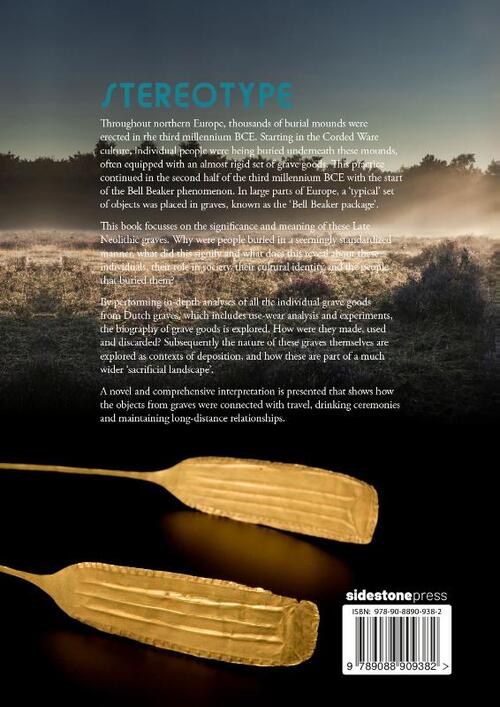40.00
1 - 2 Weken
Throughout northern Europe, thousands of burial mounds were erected in the third millennium BCE. Starting in the Corded Ware culture, individual people were being buried underneath these mounds, often equipped with an almost rigid set of grave goods. This practice continued in the second half of the third millennium BCE with the start of the Bell Beaker phenomenon. In large parts of Europe, a ‘typical’ set of objects was placed in graves, known as the ‘Bell Beaker package’. This book focusses on the significance and meaning of these Late Neolithic graves. Why were people buried in a seemingly standardized manner, what did this signify and what does this reveal about these individuals, their role in society, their cultural identity and the people that buried them? By performing in-depth analyses of all the individual grave goods from Dutch graves, which includes use-wear analysis and experiments, the biography of grave goods is explored. How were they made, used and discarded? Subsequently the nature of these graves themselves are explored as contexts of deposition, and how these are part of a much wider ‘sacrificial landscape’. A novel and comprehensive interpretation is presented that shows how the objects from graves were connected with travel, drinking ceremonies and maintaining long-distance relationships. Contents: 1 Introduction. The problem of typical Late Neolithic grave sets and the lack thereof 1.1 Introduction 1.2 Beakers and burials 1.3 The rise of chiefdoms 1.4 Problems of interpreting standardized sets as expressions of individual status 1.5 Late Neolithic graves from the Netherlands 1.6 Research questions 1.7 Methodology and dataset 1.7.1 Data collection 1.7.2 Functional analysis 1.8 Outline of the thesis 2 Presentation and perception 2.1 Introduction 2.2 The presentation of self 2.3 Us and them 2.4 The cultural biography of grave goods 2.5 Concluding remarks 3 The Age of Beakers 3.1 Introduction 3.2 Late Neolithic A: The rise of Corded Ware 3.2.1 Secondary products revolution 3.2.2 The Dutch Corded Ware Culture in context 3.2.3 All Over Ornamented beakers: The rise of Bell Beaker or the demise of Corded Ware? 3.4 Late Neolithic B: Bell beakers on the horizon 3.4.1 Bell beakers in context 3.6 Typochronology 3.7 Concluding remarks 4 The Life of Beakers 4.1 Introduction 4.1.1 Late Neolithic A beakers in graves 4.1.2 Late Neolithic B beakers in graves 4.2 The production of beakers 4.2.1 Late Neolithic A Beakers 4.2.2 Experiments with wraps and cord-impressions 4.2.3 Late Neolithic B Beakers 4.2.4 Conclusions 4.3 Decoration of beakers 4.3.1 Late Neolithic motifs 4.3.2 International style beakers: CW-, AOO- and maritime bell beakers 4.3.3 Local style beakers: Dutch North-East-group versus Veluvian bell beakers 4.3.4 Conclusions 4.4 Decoration found on other forms of material culture 4.5 The ‘ugly ducklings’ 4.6 The use life of beakers 4.6.1 Late Neolithic A use life 4.6.2 Late Neolithic B use life 4.6.3 Conclusions 4.7 Placement in the grave 4.7.1 Late Neolithic A Placement in the grave 4.7.2 Late Neolithic B Placement in the grave 4.7.3 Conclusions 4.8 Beer and beakers 4.9 Concluding remarks 5 The life of Late Neolithic A grave goods 5.1 Introduction 5.2 Flint blades and daggers: Introduction 5.3 Northern flint blades 5.3.1 Production and origins from afar 5.3.2 A life of circulation 5.3.3 Placement in the grave 5.4 French daggers 5.4.1 Origins from afar 5.4.2 Production 5.4.3 Use life, and the origin of wear traces 5.4.4 Placement in the grave 5.4.5 Blades from afar 5.5 Axes 5.5.1 Local production and objects from afar 5.5.2 A useful life 5.5.3 Two axes, one toolkit? 5.5.4 Placement in graves 5.5.5 The role of axes in the Late Neolithic 5.6 Battle axes 5.6.1 Production 5.6.2 History of speculation, lives of use 5.6.3 Experiments 5.6.4 Battle axes for clearing the land 5.6.5 Placement in graves 5.7 Flakes, beads, arrowheads and other grave finds 5.7.1 Flint flakes 5.7.2 Arrowheads 5.7.3 Amber bead

- : Karsten Wentink
- : Sidestone Press Dissertations
- : 9789088909382
- : Engels
- : Paperback
- : 290
- : juni 2020
- : 1072
- : 256 x 183 x 22 mm.
- : Archeologie; Prehistorie; Steentijd: Neolithicum

